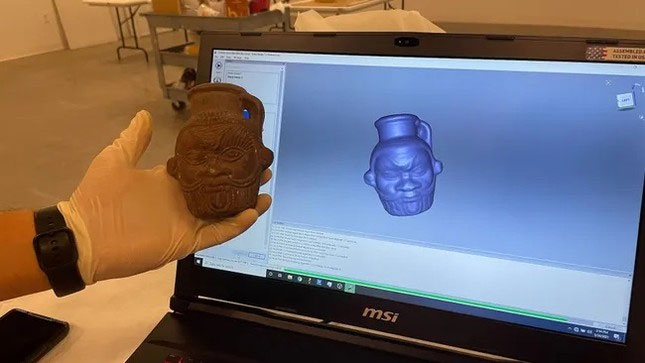Hallucinogenic ritual found 2,200 years ago
Researchers have found evidence of a hallucinogenic ritual that may have helped ancient Egyptians reenact a myth in which a dwarf deity tricks the sky goddess.
In a paper just published in the journal Scientific Reports, the team reports that they found traces of a mixture that can cause hallucinations in those who drink it. They found the remains inside a 2,200-year-old jar that featured an image of Bes , an ancient Egyptian dwarf god associated with fertility, joy, and music.

An ancient Egyptian vase depicting the dwarf god Bes, next to a 3D computer model of it, believed to contain a hallucinogenic drink. (Photo: Cassidy Delamarter).
The team conducted a chemical analysis of the organic matter left inside the jar, discovering traces of wild elm (Peganum harmala), Egyptian lotus (Nymphaea nouchali var. caerulea), and a plant from the genus Cleome, all of which have been shown to have 'psychotropic and medicinal properties ,' the team wrote in their paper. They also discovered remnants of sesame seeds, pine nuts, licorice, and grapes—a combination 'commonly used to make drinks look like blood ,' the team said.
Researchers also discovered remains of human body fluids such as saliva and blood, suggesting that people had drunk the mixture.
Hallucinogenic to the sky goddess associated with fertility
These findings led the team to believe that the ancient Egyptians were attempting to recreate the 'Myth of the Eye of the Sun.' In the story, Bes appeased Hathor, a sky goddess associated with fertility, by 'serving her an alcoholic drink mixed with a plant-based medicine disguised as blood to put her into a deep sleep ,' the team wrote in the paper.
"It can be inferred that this Bes jar was used for some kind of ritual to reenact what happened in an important event in Egyptian mythology," the team added .
The dwarf god Bes was associated with childbirth, and women may have visited oracles to seek predictions about how their pregnancies would proceed.
The vase is now housed at the Tampa Museum of Art after being acquired by a private collector who purchased it from the Maguid Sameda Art Gallery in Cairo in 1960.
- Study hallucinogenic fungi to treat depression
- How does hallucinogenic mushroom affect your body?
- Discovering a mysterious 2,000-year-old ritual bath in Israel
- Miraculous mushrooms help treat depression in humans
- The 'magic mushroom' compound could replace depression medicine
- Discovering Maya magic medicine that causes hallucinations in the most unexpected place
- Discover the mechanism of hallucinogenic fungal action on the brain
- Discover the oldest ritual mask in Japan
- Ritual hunting site discovered in the Jordan desert from 7,000 BC
- The truth behind the 'quarter' of the 3000-year-old was discovered by Swedish archaeologists
- Is the 'decree' ritual really effective?
- Strange human head carvings found in Turkey
 Discovered an ancient centipede fossil 99 million years old
Discovered an ancient centipede fossil 99 million years old Discovered bat-like dinosaurs in China
Discovered bat-like dinosaurs in China Discovered a 200-year-old bronze cannon of the coast
Discovered a 200-year-old bronze cannon of the coast Discover 305 million-year-old spider fossils
Discover 305 million-year-old spider fossils